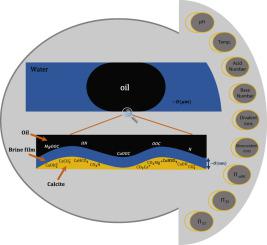Current Opinion in Colloid & Interface Science ( IF 7.9 ) Pub Date : 2020-10-13 , DOI: 10.1016/j.cocis.2020.101393 Haoli Guo , Negar Nazari , Soheil Esmaeilzadeh , Anthony R. Kovscek

|
Low salinity water injection (LSWI) is the process of injecting modified salinity brine with controlled ionic composition to achieve increased oil recovery compared to conventional waterflooding. This paper reviews the most recent advances in proposed low salinity mechanisms, but specifically emphasizes the role of thin liquid films in crude oil/brine/rocks systems. Importantly, thin water films on rock surfaces affect hydraulic resistance of pore channels as well as phase-trapping mechanisms. As films become thicker, they provide greater lubrication of oil droplets and hence, flow resistance decreases. Consequently, films dictate oil and water distribution in porous media and determine the wettability of crude oil/brine/rock systems under static and dynamic conditions. The stability of the thin water films depends on the interactions between the oil/brine and the calcite/brine interfaces through van der Waals, electrostatic, and structural forces.
中文翻译:

批判性地回顾了薄液膜在盐度卤水回收工艺中的作用
与常规注水相比,低盐度注水(LSWI)是注入具有受控离子组成的改性盐度盐水以提高采油率的过程。本文回顾了提出的低盐度机理的最新进展,但特别强调了液膜在原油/盐水/岩石系统中的作用。重要的是,岩石表面的水薄膜会影响孔隙通道的水力阻力以及相捕集机制。随着膜变厚,它们可提供更大的油滴润滑性,因此流阻降低。因此,薄膜决定了油和水在多孔介质中的分布,并决定了原油/盐水/岩石系统在静态和动态条件下的润湿性。











































 京公网安备 11010802027423号
京公网安备 11010802027423号